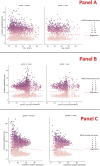A novel scale for anxiety-related fixation instability during laser in situ keratomileusis
- PMID: 40102567
- PMCID: PMC11920216
- DOI: 10.1038/s41598-025-92048-y
A novel scale for anxiety-related fixation instability during laser in situ keratomileusis
Abstract
This cohort study aimed to investigate the correlation between the severity of anxiety during laser in situ keratomileusis (LASIK) and fixation instability, as measured and plotted by the eye tracker during photo-ablation, and to develop a novel quantitative scale for anxiety-related fixation instability. LASIK was performed to correct myopia and hypermetropia with and without astigmatism in 2435 eyes of 2435 patients. Participants fulfilled the seven-item anxiety sub-score of the Hospital Anxiety and Depression scale questionnaire for scaling patients' anxiety levels before LASIK into normal, borderline, and anxiety case groups. The eye-tracking pupil center position plots, patient's heart rate, and surgeon-reported level of patient's cooperation during the procedure were analyzed. An anxiety-related fixation instability score (FIS) was calculated, for which the best cut-off points to differentiate between normal, borderline, and anxiety case groups were defined. The FIS showed a high performance in separating participants into normal, borderline, and anxiety case groups and when used as a scale (0-90), values from 0 to 12 are considered normal, from 13 to 36 are considered borderline, and from 37 to 90 are considered anxiety cases. The FIS and scale are useful objective tools to quantify anxiety-related fixation instability during LASIK.
Keywords: Anxiety; Eye-tracker; Fixation instability; Hospital Anxiety and Depression Scale; Laser in situ keratomileusis.
© 2025. The Author(s).
Conflict of interest statement
Declarations. Competing interests: The authors declare no competing interests. Ethical approval and consent to participate: The study was conducted under the tenets of the Declaration of Helsinki and after approval of the Ethical Committee of the Faculty of Medicine, Assiut University, Egypt (IRB: 04-2023-300302). All patients signed a written informed consent to participate in the study. Clinical trial registration information is publicly available at ClinicalTrials.gov: NCT06148428. Consent for publication: All patients signed a written informed consent for publication of their clinical data and/or clinical images. Declaration of generative AI in scientific writing: We used the Python programming language (version 3.9.13) to write scripts for our statistical analyses. We performed all our statistical analyses using the Scipy (Scientific Computing tools for Python, version 1.8.1) and scikit-learn (version 1.1.1) libraries for Python.
Figures








Similar articles
-
Laser in situ keratomileusis to correct myopia, hypermetropia and astigmatism after penetrating keratoplasty for keratoconus: a series of 27 cases.Can J Ophthalmol. 2001 Dec;36(7):391-6; discussion 396-7. doi: 10.1016/s0008-4182(01)80083-1. Can J Ophthalmol. 2001. PMID: 11794388
-
Intraocular lens implantation and laser in situ keratomileusis (bioptics) to correct high myopia and hyperopia with astigmatism.J Refract Surg. 2001 Mar-Apr;17(2 Suppl):S234-7. doi: 10.3928/1081-597X-20010302-19. J Refract Surg. 2001. PMID: 11316030
-
Symptoms and Satisfaction of Patients in the Patient-Reported Outcomes With Laser In Situ Keratomileusis (PROWL) Studies.JAMA Ophthalmol. 2017 Jan 1;135(1):13-22. doi: 10.1001/jamaophthalmol.2016.4587. JAMA Ophthalmol. 2017. PMID: 27893066
-
Wavefront excimer laser refractive surgery for adults with refractive errors.Cochrane Database Syst Rev. 2020 Dec 18;12(12):CD012687. doi: 10.1002/14651858.CD012687.pub2. Cochrane Database Syst Rev. 2020. PMID: 33336797 Free PMC article.
-
Laser-assisted in-situ keratomileusis (LASIK) with a mechanical microkeratome compared to LASIK with a femtosecond laser for LASIK in adults with myopia or myopic astigmatism.Cochrane Database Syst Rev. 2020 Apr 7;4(4):CD012946. doi: 10.1002/14651858.CD012946.pub2. Cochrane Database Syst Rev. 2020. PMID: 32255519 Free PMC article.
References
-
- Arba-Mosquera, S. & Aslanides, I. M. Analysis of the effects of Eye-Tracker performance on the pulse positioning errors during refractive surgery. J. Optom.5(1), 31–37 (2012).
-
- Luengo Gimeno, F., Chan, C. M., Li, L., Tan, D. T. & Mehta, J. S. Comparison of eye-tracking success in laser in situ keratomileusis after flap creation with 2 femtosecond laser models. J Cataract Refract Surg.37(3), 538–543 (2011). - PubMed
MeSH terms
LinkOut - more resources
Full Text Sources
Medical

